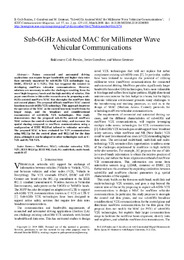Por favor, use este identificador para citar o enlazar este ítem:
https://hdl.handle.net/11000/5074Registro completo de metadatos
| Campo DC | Valor | Lengua/Idioma |
|---|---|---|
| dc.contributor.author | Coll Perales, Baldomero | - |
| dc.contributor.author | Gozalvez, Javier | - |
| dc.contributor.author | Gruteser, Marco | - |
| dc.contributor.other | Departamentos de la UMH::Ingeniería de Comunicaciones | es |
| dc.date.accessioned | 2019-03-27T10:18:15Z | - |
| dc.date.available | 2019-03-27T10:18:15Z | - |
| dc.date.created | 2019-02-15 | - |
| dc.date.issued | 2019-03-27 | - |
| dc.identifier.issn | 0163-6804 | - |
| dc.identifier.uri | http://hdl.handle.net/11000/5074 | - |
| dc.description.abstract | Sub-6GHz vehicular communications (using DSRC, ITS-G5 or C-V2X) have been developed to support active safety applications. Future connected and automated driving applications can require larger bandwidth and higher data rates than currently supported by sub- 6GHz V2X technologies. This has triggered the interest in developing mmWave vehicular communications. However, solutions are necessary to solve the challenges resulting from the use of high-frequency bands and the high mobility of vehicles. This paper contributes to this active research area by proposing a sub-6GHz assisted mmWave MAC that decouples the mmWave data and control planes. The proposal offloads mmWave MAC control functions (beam alignment, neighbor identification and scheduling) to a sub-6GHz V2X technology, and reserves the mmWave channel for the data plane. This approach improves the operation of the MAC as the control functions benefit from the longer range, and the broadcast and omnidirectional transmissions of sub-6GHz V2X technologies. This simulation study demonstrates that the proposed sub-6GHz assisted mmWave MAC reduces the control overhead and delay, and increases the spatial sharing compared to a mmWave-only configuration (IEEE 802.11ad tailored to vehicular networks). The proposed MAC is here evaluated for V2V communications using 802.11p for the control plane and 802.11ad for the data plane. However, the proposal is not restricted to these technologies, and can be adapted to other technologies such as C-V2X and 5G NR. | es |
| dc.description.sponsorship | B. Coll-Perales and J. Gozalvez acknowledge the support of the Spanish Ministry of Economy, Industry, and Competitiveness, AEI, and FEDER funds (TEC2017-88612-R, TEC2014-57146-R) | - |
| dc.description.sponsorship | The Generalitat Valenciana (APOSTD/2016/049) | - |
| dc.format | application/pdf | es |
| dc.format.extent | 7 | es |
| dc.language.iso | eng | es |
| dc.rights | info:eu-repo/semantics/openAccess | es |
| dc.subject | MmWave | es |
| dc.subject | MAC | es |
| dc.subject | vehicular networks | es |
| dc.subject | V2X | es |
| dc.subject | V2V | es |
| dc.subject | IEEE 802.11p | es |
| dc.subject | IEEE 802.11ad | es |
| dc.subject | 5G | es |
| dc.subject | multi-link | es |
| dc.subject | multi-band | es |
| dc.subject | multi-RAT | es |
| dc.subject.other | 621.3 - Ingeniería eléctrica. Electrotecnia. Telecomunicaciones | es |
| dc.title | Sub-6GHz Assisted MAC for Millimeter Wave Vehicular Communications | es |
| dc.type | info:eu-repo/semantics/article | es |
| dc.identifier.doi | 10.1109/MCOM.2019.1800509 | - |
| dc.relation.publisherversion | https://doi.org/10.1109/MCOM.2019.1800509 | - |

Ver/Abrir:
Sub6GHzAssistedmmWaveMACV2X_IEEECommMag_CollGozalvezGruteser_AuthorPostPrint.pdf
353,68 kB
Adobe PDF
Compartir:
 La licencia se describe como: Atribución-NonComercial-NoDerivada 4.0 Internacional.
La licencia se describe como: Atribución-NonComercial-NoDerivada 4.0 Internacional.
.png)